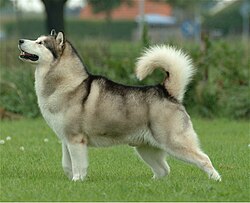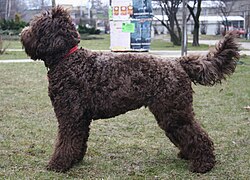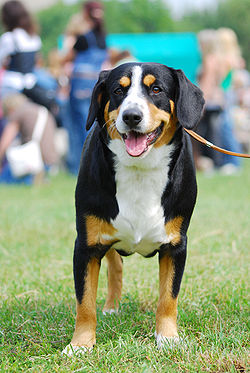
Alaskan Malamute...
Alaskan malamute - jedna dog breeds with
belonging to Spitz group
and primary
dogs, classified in the northern section of train dogs.
Historical
Originally bred as a dog pull - sleddog ; name comes from the tribe Mahlemiute , living in highlands western Alaska ; native dogs were probably crossed with larger dogs settlers arrived in time " gold rush" to make it bigger, to raise dogs to pull heavy loads. DNA tests confirm that this is one of the oldest breeds [1] . Malamutes almost not changed his appearance and character.
Construction
Compact (Compact), strong bones.
head and skull. The head is broad and strong especially in comparison with other primitive races, but it should be in proportion to the body. Skull between ears are broad, gradually tapering towards the eyes. Surface of the skull between the ears and moderately rounded, vaulted skull decreases in the direction of the eyes, but comes up to her cheeks, which remain flat. Slight furrow between the eyes. Skull and muzzle parallel, with only a small breakthrough at the junction.
Muzzle Muzzle strong, very slightly tapering towards the nose, deep. Muzzle should be large, but not too broad, in proportion to the size of the skull, with a close fitting lips. Lips, eye rims and nose black (Except for red fish), so is acceptable. "Snow nose" with a vertical stripe nude. Jaws - Powerful with large teeth.
Teeth Scissor bite.
Eyes Brown, almond shaped, medium size, set obliquely. Dark eyes are preferred. Blue eyes are disqualifying defect.
Ears Ears of medium size, erect. ear have a triangular shape, slightly rounded at the tips. Embedded are quite wide at the edges of the skull. Lower part ear should be combined with the skull on the line inside corners of the eyes, which raised his ears seem a bit protruding at the sides. Ears to the front when the dog is interested in tilted slightly forward, and when the dog runs may be submitted to the ears back on his skull.
Neck The neck should be strong, moderately convex, moderately arched.
shoulders and forelimbs average Shoulders oblique, forelegs well boned, muscular, straight up to the wrists, which are short and strong, slightly sloping when we look in profile. Alaskan Malamute limbs are strong.
Hindquarters Broad and strongly muscled. Stifle moderately bent, hocks strong and broad, moderately angulated, the traffic moving in the same line as the front legs, not too broad nor too narrow. Dewclaws on hind legs are not desirable and are removed shortly after birth.
Torso Chest should be deep and strong, the body strong, firm but not too short. Feet large, compact, deep, with strong cushions, tailored to overcome the huge space in the snow.
Back Back should be straight and slightly sloping to the hips.
Loin Loin well muscled, not too short it would have a negative impact on freedom of movement.
Intermediate Tail set high, "coming out" directly from the back line, very hairy and sickle carried over the back. It is not tightly curled, broken or hanging from the side of the trunk or lying on their backs.
coat and coloring
- coat is dense, with thick undercoat , slightly harsher and longer than the Siberian Husky .
- COLOUR occurs in shades of gray and white, sobolowo-white, black and white, wolf-and-white, red and white or pure white.
behavior and character
have an opinion friendly to people, but maszerzy often have trouble with their readiness to fights with other dogs, these dogs often exhibit a tendency to hunt. They love children and are friendly to strangers. They have a strong sense of hierarchy in the herd and the related tendency attempts to dominate family members. Malamutes are dogs suited to low temperature and continuous operation, they need appropriate activities such as competitions with appropriately severe uciągiem, jogging or cycling on a very regular long walks. Can not stand the loneliness and inactivity.
UTILIZATION
Although they are still used as draft dogs (mainly for recreation and sports, chariot), most Malamutes today are kept as family dogs and representation. Do not meet as a guard dog .
best if your dog has the opportunity to participate in dog sports such as: racing sled (sleds and carts), uciągi (weight pulling), skijoring or skijoring (dog pulling a man on skis), Canicross (running with the dog), dogtrekking (orienteering with a dog), bikejoring (dog pulling a man on a bike), racing dog pack.
This breed was designed to haul big loads at low speeds, and therefore is not predestined to take part in races. The team not suitable for transmission Sprint, much better suited for long distances. Quite large numbers are involved in the world's great races, dog sled like Iditarod , La Pirena , Alpentrail , Yukon Quest, Femundslopet , Copper Basin 300 Sled Dog Race Klondike, Finnmarkslopet, La Grande Odyssée, Nordic Open.
Malamutes specialty called "locomotives of the North, however, try to pull, or competition that requires no speed, but strength and excellent pulling techniques. Record towing a Alaskan Malamute (Bering dog, owned by Trnena Katerina, Czech Republic) in competition on Polish territory is 4900 kg. [2]
Health and Care
relatively common disease occurring in this breed are: hip dysplasia , inherited polyneuropathy, common in northern breeds with eye problems (especially cataracts, PPM , Distichiasis ).
thick coat makes it susceptible to heat Malamutes. They need a hot day more water than other breeds of dogs and the possibility of shelter in the shade. At the time there is a need for more frequent shedding of dead hair comb (undercoat) fine toothed comb. Requires daily to meet the needs of their large motor in the open air.
|

Alaskan Malamute |
| Other names | Aljaški Malamute, Mal, Malamut |
| Country of | U.S. |
| Dimensions |
| | Height 58 - 63.5 cm |
| Weight | 1935-1945 kg |
| Classification |
| FCI | Group V, Section 1,
No pattern 243 |
| AKC Working | |
| | ANKC Group 6 |
| | CKC Group 3 - Working Dogs |
| KC (UK) | Working |
| NZKC | Utility |
| UKC | Group 5 - Northern Breed |
| Breed |
| FCI • AKC • ANKC • CKC • KC (UK) • NZKC • AHS |
|













